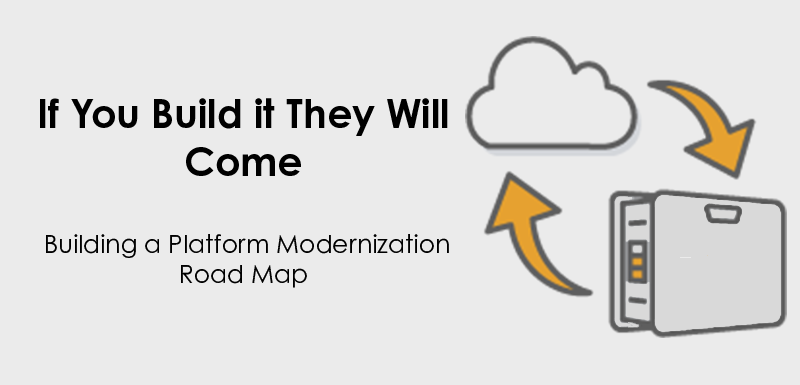
One of the biggest mistakes IT can make it to think “If we build it, they will come." This holds true, especially in a platform modernization initiative. The future state architecture must provide technological capabilities that tightly align with business initiatives and strategic direction. To accomplish this, you must incorporate the organizations strategic objectives. The resulting IT architecture roadmap must be meticulously planned, managed and implemented. The implementation will be driven by which project being implemented will allow the build out of a component of the future state architecture. This can be accomplished using an architecture framework such as The Open Group Architecture Framework, or TOGAF.
Platform Modernization help organizations realize new efficiencies resulting in increased productivity and realized cost savings. Platform Modernization aims to retain and extend the value of the legacy investment through migration to newer, more cost-effective platforms.
The decision to modernize must be carefully examined to ensure the cost does not outweigh the overall benefit. The journey is taken over time by incrementally modernizing components of the IT landscape.
The first step in the journey is to gather and validate high level business requirements. The two main categories include current and aspirational state requirements. The goal is to determine how the enterprise needs to operate to achieve the business goals and responds to the strategic drivers. I will not get into details of requirements gathering, except to say that the business’ strategic drivers and future state vision must be used to tease out what capabilities will be needed to satisfy the future state requirements.
The next step is to compile an Architecture Vision. The objective of the Architecture Vision is to develop a high-level aspirational architecture of the capabilities and business value to be delivered as a result of the proposed platform modernization. The Architecture Vision should include business process models / use case models, data and application models. As you can imagine, the business requirements (current & future) are the key input to this phase.
After the Architecture Vision is complete you can start compiling the Technical Architecture. The Technical Architecture is where the typical technical architecture components such as hardware, software and communications technology are designed. It is a good practice to ensure there is a mapping of each business capability back to the related architecture component.
Once the future state Technical Architecture is design established, you then embark on implementing the architecture. This is done through the identification of opportunities and solutions which describes the process of identifying major implementation projects and grouping them into work packages that deliver the Target Architecture a piece at a time. Keep in mind that there may be a series of prerequisites associated with delivering the individual architecture components. Once this is done, you can embark on Migration planning. Migration planning could be thought of as your roadmap. It describes the development of a detailed Implementation and Migration Plan that addresses how to move from the Baseline architecture to the Target Architecture.
While on the journey from Baseline to Target Architecture, you must adhere to some form of Implementation governance and Architecture change management. Implementation governance provides architectural oversight of the implementation. This is typically done using an Architecture Change Board. Individual projects must present their designs to the board to ensure they are in alignment with the enterprise objectives in the Future State Architecture. Architecture change management must also be followed. This establishes procedures for managing change to the new architecture. Although you have a Future State Architecture, things may change over time and this change must be managed appropriately.
The important takeaway here is that the business’ strategic drivers and future state vision must be used to tease out what capabilities will be used to satisfy the future state architecture requirements. Technological capabilities must tightly align with business initiatives, and strategic direction. The steps briefly described above are part of the TOGAF Architecture Development Methodology (ADM). For a more in depth look into the ADM, feel free to research this on your own, and possibly strive for certification. Although “If you build it they will come” usually does not work; “ If you build it with business goals in mind they will come” most certainly will.